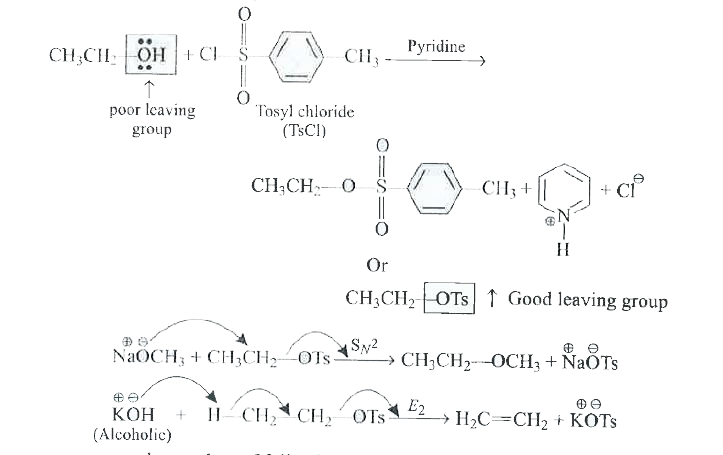3−Phenol propanic acid (B) can be prepared by both nitrile and carbonation method as shown.

Path I gives a good yield of (B).
ӨCN initiates elimination reaction.
If both (A) are (R) are true and (R) is the correct explanation of (A).
If both (A) and (R) are true but (R) is not the correct explanation of (A).
If (A) is true but (R) is false.
If (A) is false but (R) is true.
The correct Answer is:A
Since 3−phenol propanoic acid is 1∘RX, preparation by both methods can occur.
Topper's Solved these Questions
- CARBOXYLIC ACIDS AND THEIR DERIVATIVESBOOK - CENGAGE CHEMISTRY ENGLISHCHAPTER - CARBOXYLIC ACIDS AND THEIR DERIVATIVESEXERCISE - Exercises Archives (Single Correct)
10 Videos
- CARBOXYLIC ACIDS AND THEIR DERIVATIVESBOOK - CENGAGE CHEMISTRY ENGLISHCHAPTER - CARBOXYLIC ACIDS AND THEIR DERIVATIVESEXERCISE - Exercises Archives (Assertion-Reasoning)
2 Videos
- CARBOXYLIC ACIDS AND THEIR DERIVATIVESBOOK - CENGAGE CHEMISTRY ENGLISHCHAPTER - CARBOXYLIC ACIDS AND THEIR DERIVATIVESEXERCISE - Exercises (Singlecorrect)
64 Videos
- BIOMOLECULESBOOK - CENGAGE CHEMISTRY ENGLISHCHAPTER - BIOMOLECULESEXERCISE - Exercises Archives (Analytical And Descriptive)
8 Videos
- CHEMICAL KINETICSBOOK - CENGAGE CHEMISTRY ENGLISHCHAPTER - CHEMICAL KINETICSEXERCISE - Archives Subjective
23 Videos
Similar Questions
Succinic acid (B) can be prepared by both nitrile and carbonation method as shown.

Both paths give good yields of (B).
(A) with Mg would lead to the loss of vicinal Br atoms to give alkene and MgBr2.
View SolutionAn alkene A on ozonolysis yields acetone and an aldehyde. The aldehyde is easily oxidised to an acid B. When B is treated with bromine in presence of yields a compound C which on hydrolysis gives a hydroxyle acid D. This acid can also be obatined from acetone by the reaction with hydrogen cyanide followed by hydrolysis. Identify the compounds A, B C and D.
View Solution
Knowledge Check
Alcohols are converted to tosylates by treatment with p-toluene sulfonyl chloride (TsCI) in the presence of pyridine. This overall process converts a poor leaving group (өOH) into good one (өOTs). A tosylate is a good leaving group because its conjugated acid p-toluene sulfonic acid is strong acid.
Because alkyl tosylates have good leaving groups, they undergo both nucleophilic substitution and β-elimination.

Find the major product of following reaction :
 A
A B
B C
C D
D
Alcohols are converted to tosylates by treatment with p-toluene sulfonyl chloride (TsCI) in the presence of pyridine. This overall process converts a poor leaving group (өOH) into good one (өOTs). A tosylate is a good leaving group because its conjugated acid p-toluene sulfonic acid is strong acid.
Because alkyl tosylates have good leaving groups, they undergo both nucleophilic substitution and β-elimination.

What would be the major product of following reactions ?
 A
A B
B C
C D
D
Alcohols are converted to tosylates by treatment with p-toluene sulfonyl chloride (TsCI) in the presence of pyridine. This overall process converts a poor leaving group (өOH) into good one (өOTs). A tosylate is a good leaving group because its conjugated acid p-toluene sulfonic acid is strong acid.
Because alkyl tosylates have good leaving groups, they undergo both nucleophilic substitution and β-elimination.

Identify the final product of following sequence of reactions :
 A
A B
B C
C D
D
Explain the effect of SN2 rates for the following reactions :
(a) Increasing the polarity of solvent.
(b) Show the T.S with all partial charges for each reaction type.
(I) Me2⊕S−Me+NH3→Me⊕NH3+Me2S
(II) MeI+NH3→Me⊕NH3+IӨ
(III) MeI+ӨOH→MeOH+IӨ
(IV) Me2S⊕−Me+ӨOH→MeOH+Me2S.
View SolutionCompound (A) C6H12 gives a positive test with bromine in carbon tetrachloride. Reaction of (A) with alkaline KMnO4 yields only (B) which is the potassium salt of an acid. Write structure formulae and IUPAC name of (A) and (B).
View SolutionBoron reacts with oxygen at 700∘C to give (A). Compound (A) reacts with carbon and dry chloride to give (B) and carbon monoxide. (B) on reduction with LiAlH4 gives (C) along with LiCl and AlCl3.(C) on reaction with ammonia gives (D). Which on heating gives (E).(C) on reaction with NaH gives (F).
Compound (A) is
View Solution(a) Write chemical equations and reaction conditions for the conversion
(i) Ethene to ethanol (ii) Phenol to phenyl ethanoate
(ii) Ethanol to propan-2-ol.
(b) Give an example for each of the following reactions:
(i) Kolbe's reaction (ii) Reimer-Tiemann reaction
View SolutionBoth carbonyl compounds and acid derivatives though they contain
 grouping yet the reactions given by them are entirely different.
grouping yet the reactions given by them are entirely different.
As Aldehydes and Ketones give addition product with a nucleophile, while carboxylic acid derivatives give nucleophilic acyl substitution through addition/elimination mechanism.

Where X−=−Cl−O−O∣∣C−R−OR,−NR(R) etc.

Why aldeydes and Ketones give nucleophilic addition reaction while acid derivatives prefer nucleophilic acyl substititution reaction?
View Solution
